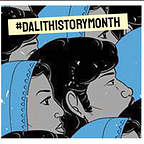The Ghost of Nangeli
Art and Concept by @chandrakari (instagram). Voice Artist @laya.chandralekha (instagram)
Artist’s Statement
The ghost of Nangeli tells her story for the first time in this animated monologue.
Nangeli was an Ezhava woman in Kerala who cut of her breast to protest the breast tax. The breast tax was not a tax lower caste women had to pay for covering their breasts, but was one of the many taxes that kept lower caste people in debt and indentured labour. Nangeli is part legend part historical figure. Depends on who you ask.
This monologue wanted to ask: why did Nangeli cut off her breasts?
What is fascinating about the story is who retells it and why. In a comic by Orjit Sen, Nangeli’s struggle is framed as an anti-casteism one, although incorrectly claiming it was a tax to cover her breast. Savarna feminist articles appropriate her as a feminist icon battling the patriarchal gaze, conveniently overlooking the casteism in the story. Amateur and professional Savarna historians are quick to invalidate Nangeli’s story and the brutality of casteism according to their interpretations of the facts. Colonial narratives transformed Nangeli’s story of anti-casteism to one of a women protecting her modesty. In each retelling, the details are changed, different meanings are extrapolated, some nuances get lost.
I wanted to bring Nangeli to life and tell her side of the story while exploring the idea of reclaiming narratives and interrogating the idea of historical legitimacy. Nangeli was ultimately fighting the brutal caste system of Kerala’s recent past. In a system where she had no voice, cutting off her breasts was the only way for her oppressors to take notice.
@chandrakari is a illustrator who likes to tell stories with pictures. She grew up both in Canada and the US.
@laya.chandralekha is a film student majoring in screenwriting & direction, when she is not acting in front of the microphone.
